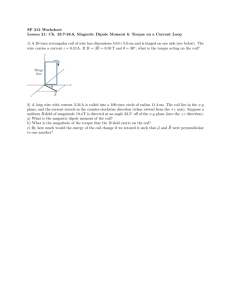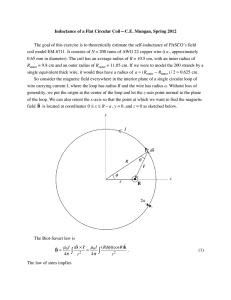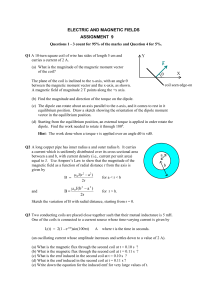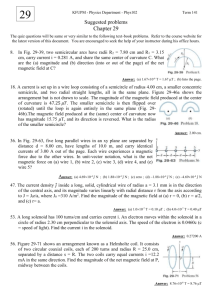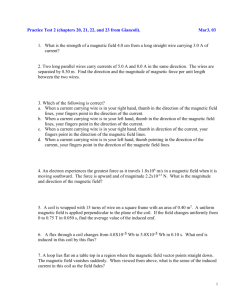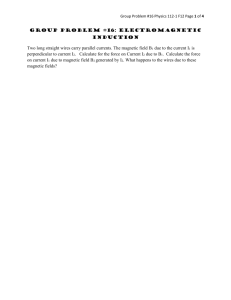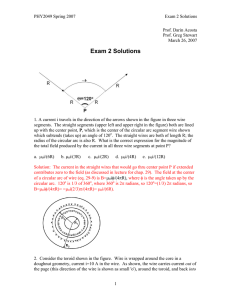Magnetic Field Problems & Solutions: Physics
advertisement
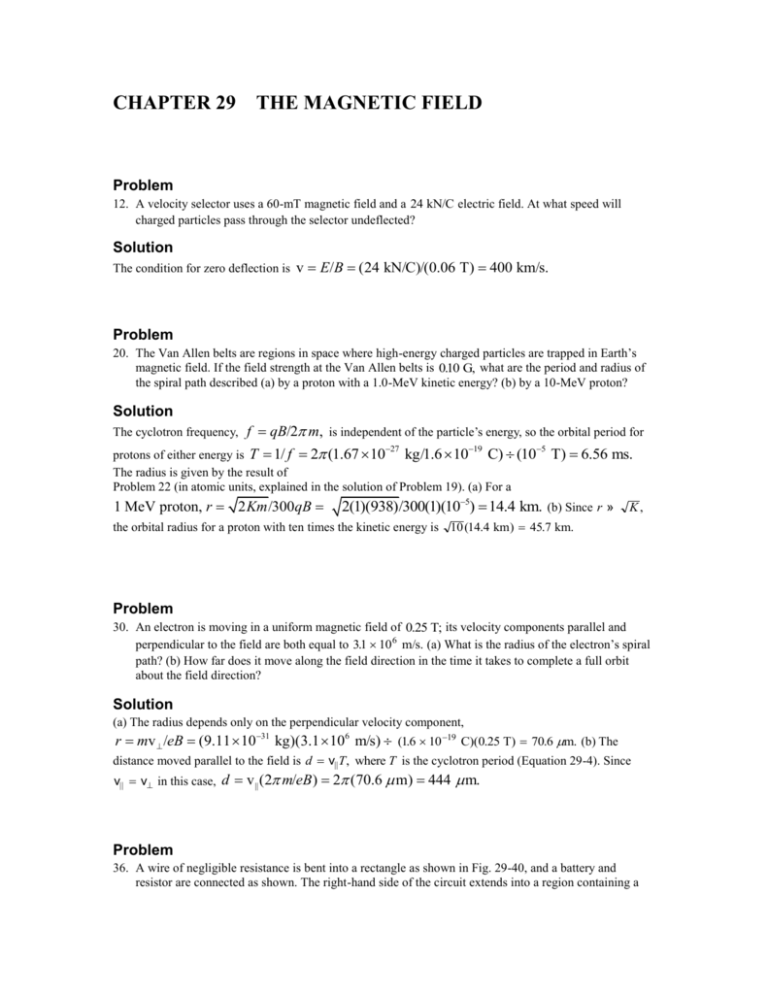
CHAPTER 29 THE MAGNETIC FIELD Problem 12. A velocity selector uses a 60-mT magnetic field and a 24 kN/C electric field. At what speed will charged particles pass through the selector undeflected? Solution The condition for zero deflection is v E/B (24 kN/C)/(0.06 T) 400 km/s. Problem 20. The Van Allen belts are regions in space where high-energy charged particles are trapped in Earth’s magnetic field. If the field strength at the Van Allen belts is 010 . G, what are the period and radius of the spiral path described (a) by a proton with a 1.0-MeV kinetic energy? (b) by a 10-MeV proton? Solution The cyclotron frequency, f qB/2 m, is independent of the particle’s energy, so the orbital period for protons of either energy is T 1/ f 2 (1.67 10 kg/1.6 10 C) (10 The radius is given by the result of Problem 22 (in atomic units, explained in the solution of Problem 19). (a) For a 27 1 MeV proton, r 2 Km /300qB 19 5 T) 6.56 ms. 2(1)(938)/300(1)(105) 14.4 km. (b) Since r » K, the orbital radius for a proton with ten times the kinetic energy is 10 (14.4 km) 45.7 km. Problem 30. An electron is moving in a uniform magnetic field of 0.25 T; its velocity components parallel and . 10 6 m/s. (a) What is the radius of the electron’s spiral perpendicular to the field are both equal to 31 path? (b) How far does it move along the field direction in the time it takes to complete a full orbit about the field direction? Solution (a) The radius depends only on the perpendicular velocity component, r mv /eB (9.11 1031 kg)(3.1 106 m/s) (1.6 10 19 C)(0.25 T) 70.6 m. (b) The distance moved parallel to the field is d v||T , where T is the cyclotron period (Equation 29-4). Since v|| v in this case, d v || (2 m/eB ) 2 (70.6 m) 444 m. Problem 36. A wire of negligible resistance is bent into a rectangle as shown in Fig. 29-40, and a battery and resistor are connected as shown. The right-hand side of the circuit extends into a region containing a uniform magnetic field of 38 mT pointing into the page. Find the magnitude and direction of the net force on the circuit. FIGURE 29-40 Problem 36 Solution. Solution The forces on the upper and lower horizontal parts of the circuit are equal in magnitude, but opposite in direction and thus cancel (see Fig. 29-40), leaving the force on the righthand wire, IB (E=R)B (12 V=3 )(0.1 m)(38 mT) 15.2 mN toward the right, as the net force on the circuit. Problem 52. A satellite with rotational inertia 20 kg m 2 is in orbit at a height where Earth’s magnetic field strength is 0.18 G. It has a magnetic torquing system, as described in Example 29-7, that uses a 1000turn coil 30 cm in diameter. What should be the current in the coil if the magnetic torque is to give the satellite a maximum angular acceleration of 0.0015 s 2 ? Solution If we require that the maximum torque from the coil, max B NIAB (from Equations 27-10 and 11), should yield the desired angular acceleration, max /I rot , then the current necessary is I max /NAB I rot /NAB (1.5 10 3 s 2 )(20 kg m 2 ) (10 3 ) 1 4 (0.3 m) 2 (1.8 10 5 T) 23.6 A. Problem 64. The coil in the loudspeaker of Fig. 29-31 consists of 100 turns of wire, 3.5 cm in diameter. The magnetic field strength at the coil is 0.64 T. Find the magnitude of the force on the speaker coil when the current in the coil is 2.1 A. Solution In Fig. 29-31(b), the magnetic force on each element of current in the wire has the same magnitude, IdB, perpendicular to the page, so the net force on N turns of diameter d is F coil IBd NIB d. (The total length of the wire is assumed to be the number of identical turns times the circumference of one turn.) For the values given, F (100)(21 . A) (0.64 T) (3.5 cm) 14.8 N. z

